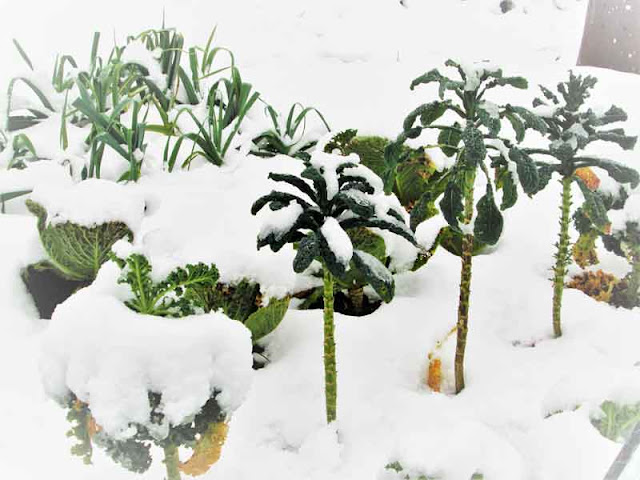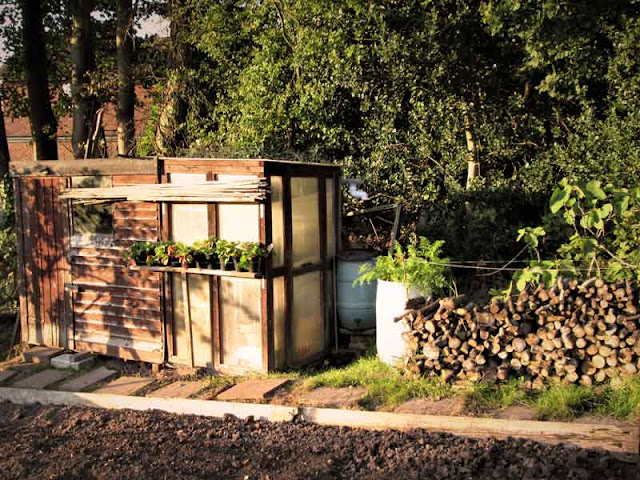It's always a pleasure, when the days are short and cold, to sit down and think about next season's seeds. Not only does it evoke thoughts of sunshine and long warm days but is a practical exercise in determining what to grow next season. Sounds a bit too early to think about next year? Well, no, not really. Potatoes will be available in four weeks time from the usual outlets or can be ordered now from seed suppliers for delivery in January. If you are going to order more specialist spuds then don't wait too long, many popular varieties sell out quickly!

Every year I have a bit of a review of the growing season, what went well, what didn't; what was relished by the family and what was just 'meh'; what crops ended up in a surplus and what we need more of. So, I've had a good think and I have complied my 2018 seed list. I'm going for good performers but with the odd new variety to add an element of experimentation. (If you don't grow something new how do you find out if it's better than your usual variety?).
As part of the review I go through my existing seed stock, throwing out packets hopelessly out of date and keeping those that I think are still useful. (In my experience, even seeds that are past their sow-by-date will often germinate but, maybe not so well. I just sow lots more of them to ensure enough plants; it's a good way to use up older packets. This is particularly true of brassicas and squashes but I've found that sweetcorn and parsnip seeds really decline by the second year after opening so you're better off sowing everything in the packet in year two).
Here we go then, my seed list for 2018:
|
Leeks
|
Musselburgh
|
|
Tomatoes
|
Alicante
|
|
Bell Peppers
|
Corno Di Roose Toro
|
|
Broad Beans
|
Bunyards Exhibition
|
|
French Bean
|
Cobra
|
|
Runner Bean
|
Firestorm
|
|
Garlic (Spring)
|
Solent Wight?
|
|
Lettuce
|
Lollo / Little Gem
|
|
Mixed Spicy Leaves
|
Mesclun Mix
|
|
Radish
|
French Breakast
|
|
Salad Onion
|
White Lisbon
|
|
Brussel Sprouts
|
Bosworth F1
|
|
Cabbage - Summer
|
Pimo II
|
|
Cabbage - Winter
|
Tundra F1
|
|
Kale
|
Curly Dwarf / Tuscan
|
|
Potatoes - First Early
|
Rocket
|
|
Potatoes - Maincrop
|
Sarpo Mira
|
|
Onion Sets
|
Sturon
|
|
Parsnip (pre-hole)
|
Gladiator F1
|
|
Carrots (barrel)
|
Sweet Candle
|
|
Carrots (plot)
|
Resistafly F1
|
|
Beetroot
|
Boltardy
|
|
Courgette
|
Defender
|
|
Pumpkin
|
Big Max
|
|
Butternut Squash
|
Hunter F1
|
|
Winter Squash
|
Crown Prince
|
|
Sweetcorn
|
Incredible F1
|
Generally I'm going for varieties that work well on my particular plot, tried and tested plants that I know will produce good crops in an average season. Sarpo Mira maincrop potatoes, I've found nothing better to avoid blight and that will go on growing into early October. They performed well again this year, I've still got two hessian sacks full of them in the shed. Rocket early spuds, plant them around the 20th March and ensure that they don't get nipped by late frosts and you'll be digging golden new potatoes in the first week of June. While often criticised for being less flavoursome than other earlies, I find Rocket tasty, prolific, they boil well and they can be harvested in just ten weeks.
Alicante tomato seed is cheap and is a quarter of the price of other popular varieties like Shirley F1, with ten times the seeds in the packet. Alicante always produce loads of medium sized tomatoes in a greenhouse; if you want a cherry type then there's plenty to have a go at. What I save in costs on some seed I spend elsewhere on slightly more expensive F1 varieties that are so superior that I can't consider anything else. For example, Brussels sprouts, cheap traditional varieties seldom stand well through the Winter, they 'blow' open; varieties such as Bosworth, Montgomery and Trafalgar are all F1 hybrids and will produce lovely sprouts that stay tight and hard into early March. Despite a pigeon attack on the leaves, I've been picking my Bosworth F1 since late October. Pay a little extra and go for the F1 sprouts if you want them for Christmas lunch in 2018.

In terms of other brassicas I'm going with my usual Primo II Summer Cabbage (also sold as Golden Acre), they are cheap, large, tasty and very reliable (if you use collars to protect against root fly and nets for the butterflies and pigeons). I didn't get on too well with Tundra F1 Winter cabbage in 2016 because I sowed and planted them too late in the season. I tried again this year, sowing them in early Spring and I currently have large cabbages in the plot that should be available well into the new year. I'm glad I stuck with Tundra F1, they are definitely worth their good reputation. Sow under glass in late March and plant out 4-6 weeks later; they'll grow throughout the Summer then will stand through the Winter.
Cobra are wonderful climbing French beans, prolific and tasty - no change this year, I've still a bag in the freezer. Last year I tried 'Firestorm' runner beans because they, (and their white flowered counterpart 'Snowstorm') are self pollinating - very useful if the weather causes a decline in insect life at the crucial time. That's what happened to me in the Summer of 2016, the first beans formed OK but something happened weather-wise and from mid-season there were no pollinated flowers; there was literally a visible dividing line on the plants between the beans and the barren area. That's why I chose to try Firestorm this season and they were great, I'm going to stick with them for 2018.

Sweet Candle carrots are brilliant and I've been growing them in a barrel this year. While I only have room for a limited amount, one carrot is large enough for a family meal and the barrel height stops the carrot fly. New to me for next season is 'Resistafly F1' carrots which I will grow in the plot without any fly protection to see how they perform. Due to my stony clay soil which is not good for carrots, I'll create a few rows by wiggling the spade back and forth and filling the resulting 'V' shaped trench with rough compost and sow on top. The alternative is to use a bar and back fill the conical hole with compost and sow a few seeds at each position, thinning to one good plant - this is the method I have used for large carrots in the past and I still use for parsnips. The bar method certainly works, I've already had a 4lb parsnip, Gladiator F1 always do well for me.

Another variety new to me for next season is the sweet pepper 'Corno Di Roose Toro'; I usually grow 'Califonia Wonder' bell peppers and they do pretty well in the greenhouse but I thought I'd have a change and go for the more elongated ''bull's horns'. As for squash, Defender F1 produce more courgettes than anyone can possibly eat especially if you turn your back for a few days and they become marrows! Nevertheless, a cheap variety like 'Black Beauty' will provide courgettes aplenty during an average Summer. In terms of Winter squash I'm going for Hunter F1 butternut as they work well in our cooler climate, though they were a little smaller than they were last year. My other choice did well, the silver skinned Crown Prince, just keep two to a vine and feed weekly for nice sized examples. My final squash is a Big Max pumpkin for carving at Halloween. Try to get one to set early in the season by pollinating by hand, it has longer to grow and develop into a decent size. Mine was 16lb this year and looked good when carved.

The Musselburgh leeks are fine, not so much damage from leek moth this Autumn, I usually get some problems even when they are covered with enviromesh until November. Musselburgh are a traditional variety but they stand so well through the Winter I have no real urge to change. Bunyard's Exhibition are a prolific broad bean; I changed from Sutton a few years back and get a much heavier crop. Maybe I'll try something different at some point but as I have the seed in stock I'll stay with Bunyard's for 2018. I've tried the popular Swift F1 sweetcorn but found that they really hated being transplanted so I'll stick with my usual 'Incredible F1' that grows strongly on my plot and take being transplanted from long root trainers where I raise them under glass.
If you fancy growing a variety you haven't tried before or, are just starting out and you're not sure what to buy then why not download the RHS's list of vegetables with the 'Award of Garden Merit' (AGM)? These varieties have been grown and tested by the RHS and have been found worthy of their recommendation, coming top of their respective trials. Seeds with the AGM stamp on the packet seldom disappoint if grown correctly. The latest AGM list can be found
HERE.
A word on where to buy. Each of the large seed retailers have online sites and seldom sell the same varieties, this can be a bit annoying if you can't find what you want in one place. They are also relatively expensive. I only use major 'named' suppliers for my maincrop Sarpo Mira potatoes and get my Rocket early spuds from my local Wilkinson store at a fraction of the price. From January onward, Wilkinson usually supply cheaply the more common seed items on my list like Sturon onion sets, garlic bulbs, Cobra French beans, White Lisbon salad onions, Musselburgh leeks, a variety of salad leaves, a good range of lettuce like Webbs Wonderful, Little Gem, Iceburg, Lollo Rossa, there's usually a few options for sweetcorn (including F1 types) and some good beetroot choices as well.

For more specialist seeds like Bosworth F1 sprouts, Sweet Candle F1 carrots, Hunter F1 butternut, etc, I have found that there are UK regulated and certified suppliers on eBay that have very large ranges at excellent prices. For example, where a 'named' major seed retailer is selling Sweet Candle carrot seeds for £2.99 a packet plus postage, a major eBay supplier is selling them for 99p with free postage and four times the number of seeds. The only difference is that they come in clear packets with a printed label rather than a glossy packet with a picture on. Personally I've found companies with extensive eBay outlets like 'Premier Seeds' and 'SeeKay' to be excellent. Yes, you might have to buy the odd item from different suppliers but that rings true for the big boys as well. So, whether you buy from your local garden centre, high street, DIY store or online, shop around for the varieties you want to try rather than just buying a variety because it happens to be in the rack.
That's it for my seed list post and annual review. I hope I've inspired you to start thinking about next season if you haven't already done so. Bye for now.













































